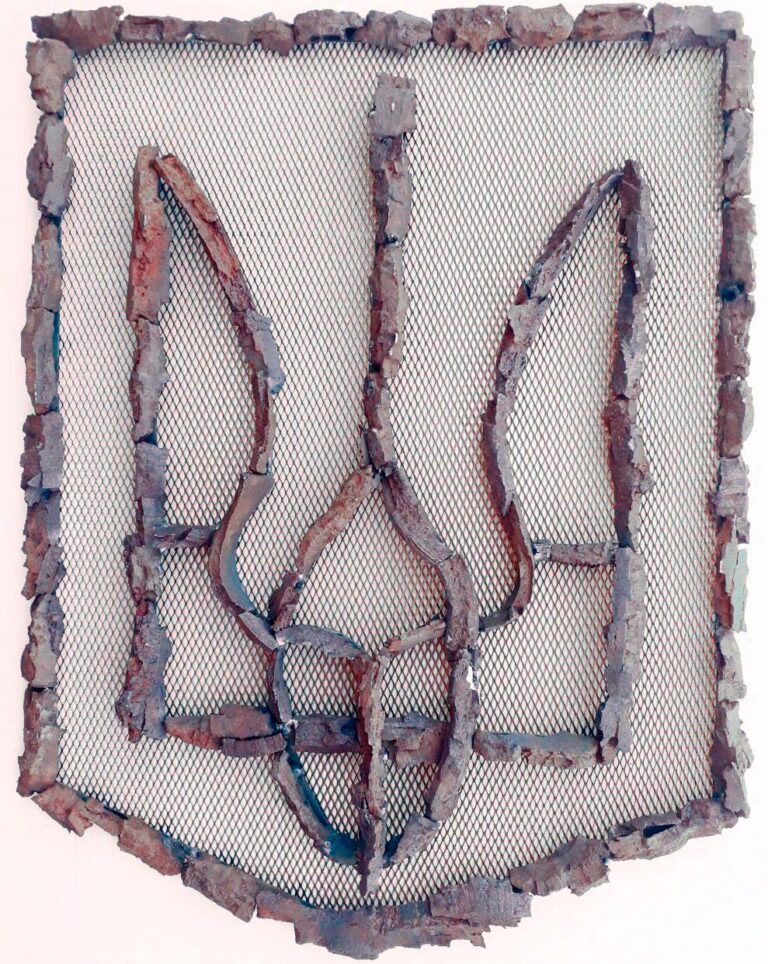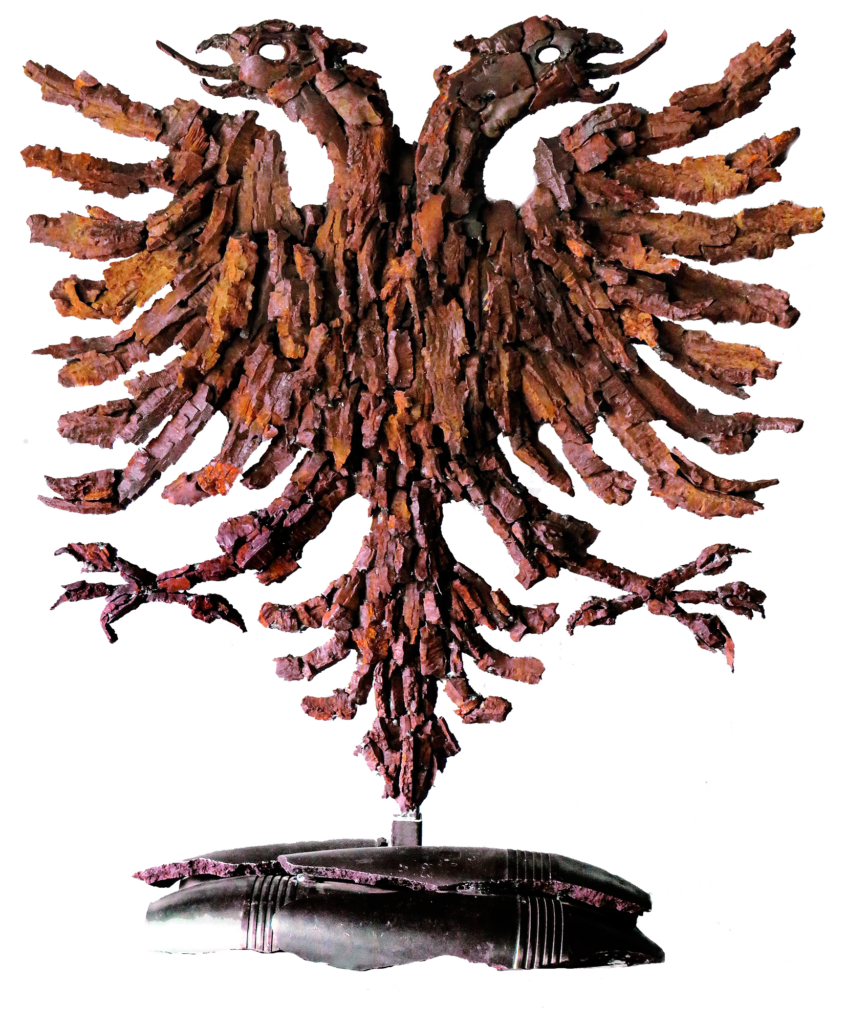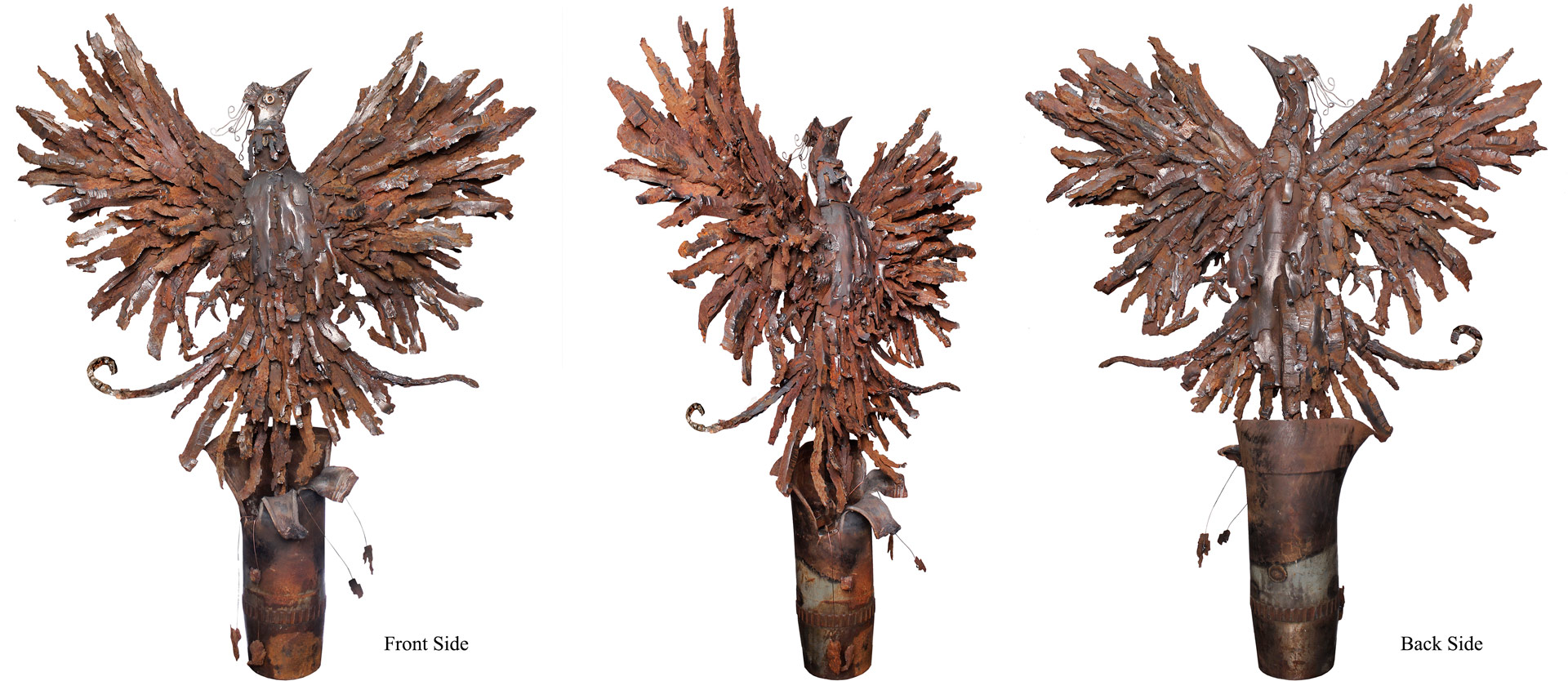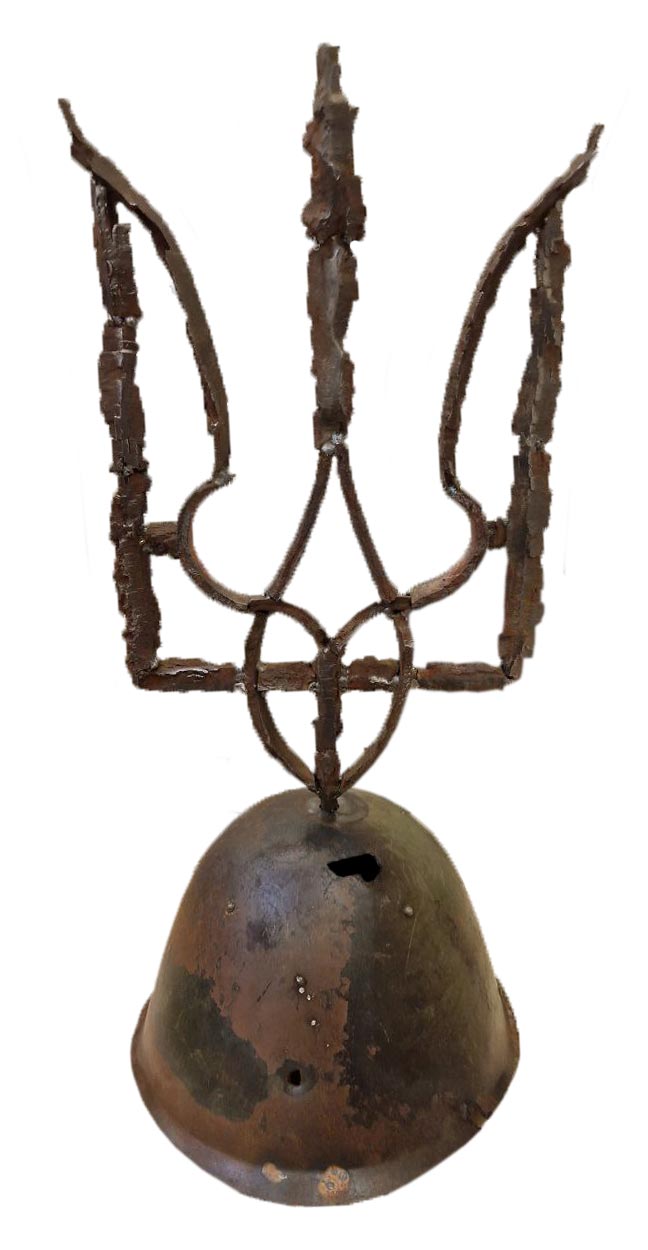The Metallurgical Symphony
of Sergey Melnikoff:
Transforming Ashes of War into Art
by Anastassia Melnikov | Photos by Mariia Universaliuk
“You are a genius, turning fragments that took lives into a great Resurrection!”
— Ludmila Leukhina
Art Beauty Industry Biotech, Kharkiv
In the profound allegory of the phoenix’s rebirth lies a universal narrative that transcends borders, inspiring nations across the globe. It imparts a poignant moral, echoing through the chronicles of history: in the aftermath of calamity, there emerges not only new life but the promise of fresh beginnings.
Within the heart-wrenching crucible of Ukraine’s ongoing struggle, a nation finds itself engulfed in the relentless fires of what feels like a ceaseless war. Amidst crumbling structures, the premature loss of young lives, the mournful cries of mothers, and the forced concealment of the next generation within the refuge of train tunnels, a parallel to the phoenix narrative unfolds. It is a testament to the enduring human spirit, a resilient flame flickering in the shadows, with the hope that one day, like the phoenix, they too will rise from the ashes.
In the midst of adversity, where the echoes of Russian rockets and Iranian-made “Shahed” drones reverberate through the nightly bombardments of Odessa’s outskirts, emerges a testament to resilience and artistic reinvention. An American artist of Ukrainian descent, Sergey Melnikoff, known by the moniker MFF, has orchestrated a transformative narrative through his collection of sculptures, each crafted from the haunting remnants of war.
Melnikoff’s crusade into metal sculpting unfolds in a modest garage cooperative on the fringes of Odessa, a city besieged by the shadows of conflict. Collaborating with master welder Viktor Belchik, they fashioned a compelling series of art objects from over one and a half tons of artillery shell fragments, mines, and dismantled Russian military machinery. This venture, a stark departure from Melnikoff’s illustrious career as a globally acclaimed photographer, thrusts him into the realm of metal sculptor extraordinaire.
From the striking installation “Wheel of Fortune” to the poignant “Ukrainian Phoenix,” Melnikoff’s sculptures transcend the boundaries of conventional artistry, immersing themselves in the collective memory of Ukrainians who sacrificed their lives in the struggle against foreign invaders.
Melnikoff’s mastery in photography has defined his artistic identity characterized by an unwavering commitment to capturing the gentleness and vulnerability inherent in nature.
He is also an advocate for humanitarian rights for which Melnikoff is a recipient of numerous accolades, including Ukrainian orders and the prestigious “Qoman Turpal” – the Hero of the Nation of the Chechen Republic of Ichkeria. Yet, faced with the ravages of war at his doorstep, he found solace and purpose in the transformation of discarded remnants into symbols of historical significance.
Delving into the genesis of Melnikoff’s metal artistry, one is confronted with a harrowing tale of personal endurances. The artist’s residence, struck in the initial bombing raid on the very first morning of conflict, triggered memories of familial sacrifice spanning generations. Melnikoff’s lineage, shaped by his father’s frontline aviation defense against the Axis Powers during WWII, forms the bedrock of his visceral connection to the unfolding tragedy on Ukrainian soil.
The shift from renowned photographer to sculptor materialized as a response to the urgent call of war. In a quest to honor his familial heritage, Melnikoff envisioned sculpting the Great Coat of Arms of Ukraine from the fragments of war. The journey demanded collaboration with a master welder of unparalleled skill.
Resilience Forged in Metal: Melnikoff's "The Unconquered Ukraine"
In the heart of Odessa’s war-torn landscape, where echoes of conflict are a haunting lullaby, Sergey Melnikoff’s artistic alchemy unveils a testament to the indomitable spirit of Ukraine in “The Unconquered Ukraine” sculpture. A symphony of iron, this magnum opus boldly features a Cossack warrior and a lion, both gripping a trident—a poignant portrayal encapsulated within the Great Coat of Arms of Ukraine.
Melnikoff’s ingenuity takes center stage as he meticulously assembles over one and a half thousand fragments from exploded ammunition, crafting an intricate mosaic that narrates a story of fortitude and defiance. Achieving a three-dimensional representation of the Ukrainian Cossack and the lion, the fragments were meticulously chosen and arranged in four layers. This eccentric approach, where fragments retain their raw form without alteration, results in a sculpture that defies convention, demanding contemplation of its stark symbolism.
During the photoshoot, the sculpture “Unconquered Ukraine,” crafted by Sergey Melnikoff, adorns St. Michael’s Square in Kyiv. Photo by Mariia Universaliuk
The monumental task of welding these fragments into a coherent whole, falls into the capable hands of Viktor Belchik, a master of metal whose workshop in Odessa becomes the hearth for this artistic transformation. The collaboration between Melnikoff and Belchik transcends mere craftsmanship; it becomes a shared journey into uncharted artistic territory.
Viktor Belchik, initially surprised by the renowned artist’s unconventional request, soon finds himself captivated by Melnikoff’s vision and dedication. As they sift through fragments for months, conversations unfold, revealing the artist’s multifaceted identity—a photographer who ventured into the battlefield to become a symbol-maker. Melnikoff’s past, as a dissident escaping the Soviet Union, amplifies the layers of his persona, ultimately earning him the title of National Hero of the Chechen Republic of Ichkeria.
THE ASHES OF WAR
Download a brochure in PDF format
In the photo: The Small Coat of Arms of Ukraine made of military ammunition debris, that Sergey Melnikoff presented to Ukrainian President Volodymyr Zelensky.
The journey of “The Unconquered Ukraine” traversed the country, from Odessa to Kyiv, culminating in a consecration ceremony at St. Volodymyr’s Cathedral. This transformative event was officiated by the Archbishop Andrew while the National Honored Academic Ukrainian People’s Choir performed a melodic backdrop.
A video clip of the Ukraine’s National Information Agency, “Ukrinform,” beautifully documents the dignified ceremony consecrating the sculpture of the Great Coat of Arms of Ukraine at Saint Volodymyr Cathedral in Kyiv on November 1, 2023
As the images captured in Michael’s Square unfold, set against the relics of conflict, Melnikoff’s vision comes to life. The weathered fragments of war coexist with the defeated Russian military equipment, creating a powerful visual narrative against the backdrop of a defiant Ukraine.
A symbolic cross atop the Great Coat of Arms, fashioned from bullets, echoes Melnikoff’s anti-war stance, infusing a powerful philosophical dimension into the sculpture. This profound symbolism, captured by rising documentary photographer Mariia Universaliuk in the heart of Kyiv, speaks to the courage of a nation and the enduring human spirit.
In the seamless collaboration between Melnikoff and Universaliuk, separated by thousands of miles, 21st-century technology becomes a conduit for storytelling. Yet, the juxtaposition of artistic creation against the grim reality of war serves as a stark reminder of the paradox of progress.
“The Unconquered Ukraine” emerges not just as a sculpture but as a profound meditation on the enduring human spirit, an artistic endeavor that transcends conventional boundaries. In the bedrock of Melnikoff’s creation, Ukraine stands not conquered, but resolute—a symbol etched in iron, challenging the world to bear witness to its unwavering strength.
Crafted from fragments of ammunition, the sculpture depicting the Great Coat of Arms of Ukraine was captured against the backdrop of Russian military equipment demolished in battle. Posing alongside the coat of arms are hereditary Cossacks Viktor Balitskyi (left) and Vyacheslav Padalko from the Ukrainian Association of Free Cossacks. Photo by Mariia Universaliuk
"Wheel of Fortune"
The work of art “Wheel of Fortune” is dedicated to the fate of the Ukrainian soldier Valery Lobanovsky who died in his first battle.
Video shows Viktor Belchik skillfully melds components of the installation “Wheel of Fortune” through electric welding.
“Wheel of Fortune” stands as an art installation rich in symbolism, conveying the unpredictable twists of a soldier’s destiny on the battlefield. At its zenith, a horseshoe, an age-old emblem of good fortune, adorns the installation. A soldier’s helmet, marked by bullet punctures, is artfully positioned atop large-caliber cartridges, encircled by a machine-gun belt housing a solitary golden bullet.
Enter Viktor Belchik, a maestro of electric welding, whose adept craftsmanship breathed life into Melnikoff’s visionary creations. The collaborative endeavor, spanning three intense months, not only birthed conceptually unique works but also catapulted Belchik into the echelons of contemporary art. His exceptional talent garnered recognition in the form of the second-degree Order of St. Equal-to-the-Apostles Prince Volodymyr from His Holiness Filaret, the Patriarch of the Ukrainian Orthodox Church.
In this symphony of metal and memory, Melnikoff and Belchik transcend the confines of conventional artistry, forging a narrative that resonates with the echoes of war and the indomitable spirit of a nation. The ashes of war find new life in their hands, transforming into sculptures that stand as both monuments to the fallen and beacons of hope in the face of adversity.
A Feathered Resurgence: Sergey Melnikoff's "The Ukrainian Phoenix" Soars in Artistic Brilliance
Within the realm of war-torn narratives, Sergey Melnikoff, an artist with American citizenship and Ukrainian heritage, transcends the grim realities of conflict. His masterpieces, “The Magnificent Eagle of Albania” and “The Ukrainian Phoenix,” not only offer Albania a symbol of gratitude but also provide Ukraine with a powerful testament to resilience.
The Magnificent Eagle of Albania
As a gesture of appreciation, Ukrainians gift Albania a majestic two-headed eagle, meticulously crafted from fragments of mines and shells. This sculpture, aptly named “The Magnificent Eagle of Albania,” symbolizes a reciprocal bond forged during the tumultuous times of war. Melnikoff channeled his artistic prowess to create a heartfelt tribute within the framework of establishing an International Rehabilitation Center for Ukrainian children in Albania—a sanctuary for those who lost limbs in the brutality of Russian bombings.
Video shows Viktor Belchik skillfully melds components of the installation “The Magnificent Eagle of Albania” through electric welding.
“The Magnificent Eagle of Albania” is a remarkable masterpiece meticulously crafted in Ukraine, using fragments of mines and shells collected from the battlefields in the fight against Russian fascism in the 21st century. Photo by Mariia Universaliuk
The Ukrainian Phoenix
Delving into the inventive realm of “war artifacts,” the artist, known under the moniker MFF, breathes life into a mythical bird using feather-like fragments of ammunition called “The Ukrainian Phoenix.” Ludmila Leukhina, owner of the Art Beauty Industry Biotech company in Kharkiv, aptly hails Melnikoff as a genius for transforming fragments that once claimed lives into a symbol of resurrection.
The Phoenix, a mythical bird synonymous with eternal renewal, finds a poignant reimagining in Melnikoff’s hands. Rich in symbolism, the sculpture emerges from the remnants of a Russian artillery shell explosion, its upraised wings defiantly asserting freedom. The fragments, delicately suspended on thin wires, imbue the iron bird with a lifelike quality, subtly responding to the viewer’s slightest movement.
Rooted in ancient mythology, the Phoenix becomes a vessel for diverse symbols across cultures and religions. In alchemy, it marks the conclusion of the Great Work, the attainment of the philosopher’s stone. Melnikoff ingeniously captures this transformative stage, equating the Phoenix with a liberated soul and symbolizing Ukraine’s rebirth after enduring one of the 21st century’s most brutal military assaults.
“The Ukrainian Phoenix,” clad in a rusted patina, showcases the artist’s mastery in blending ancient legends with contemporary tribulations. The iron bird’s reddish hue, polished in some areas to metallic brilliance, pays homage to the timeless tales of resurrection while simultaneously embodying the scars of recent conflict.
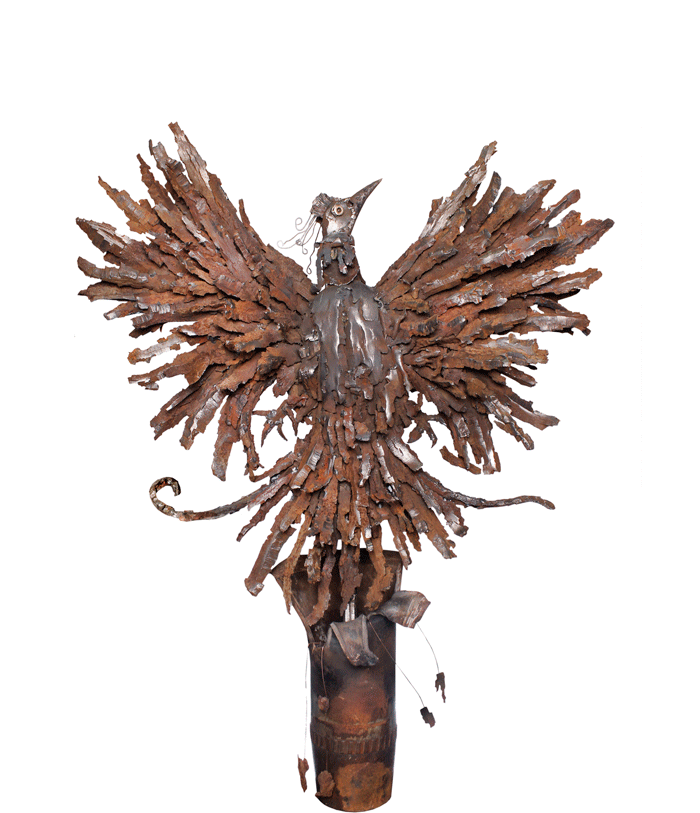
CREATIVITY AWARDS

Sergey Melnikoff was honored with the Order of St. Archangel Michael and the Order of Unity and Will to Victory in recognition of his remarkable sculptures crafted from fragments of military ammunition.

Victor Belchik was presented with the 2nd degree Order of the Holy Equal-to-the-Apostles Prince Volodymyr the Great as a testament to his outstanding contributions.
In Melnikoff’s hands, “The Ukrainian Phoenix” transcends the bounds of mere sculpture, becoming a powerful symbol of a nation’s tenacity, rising from the ashes of war. Through the lens of art, the artist sparks contemplation on the enduring spirit of a country marked by strife, crafting an immortal emblem of resilience in the face of adversity.
Melnikoff’s devotion lies not only in the creation of anti-war installations but in the subsequent charitable endeavors tied to these creations. The auctioning of these sculptures aims to fund the International Rehabilitation Center for Ukrainian children who have lost limbs due to the brutality of war—a noble cause that elevates the purpose of art beyond aesthetics.
The helmet of a Russian soldier, pierced by a bullet from a Ukrainian soldier, now bears the mark of Sergey Melnikoff’s defiance: a trident, firmly embedded by his own hand, symbolizing the resilience of the Ukrainian state. The private collection of Aleksandr Kostetskyi. Photo by Mariia Universaliuk





